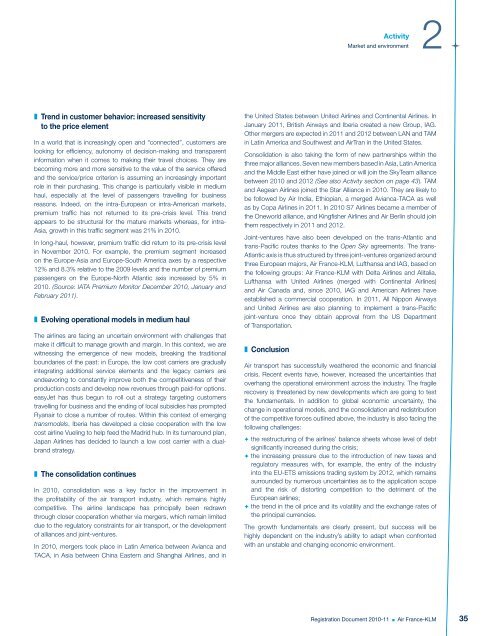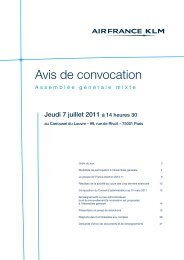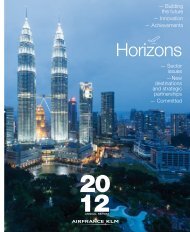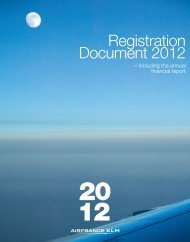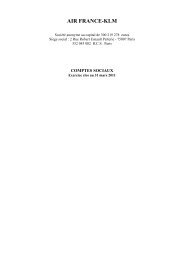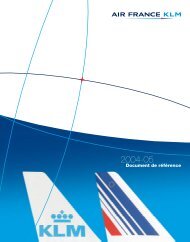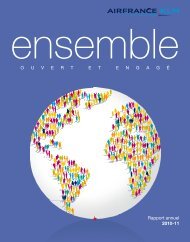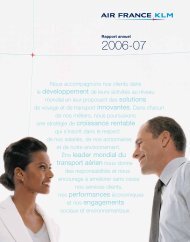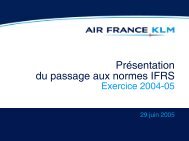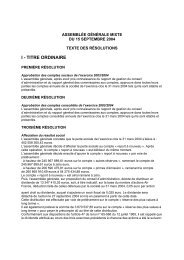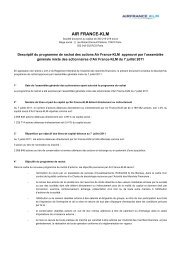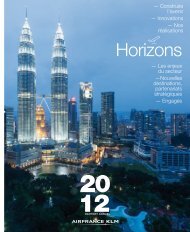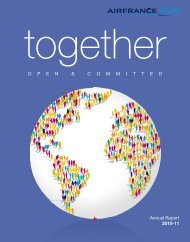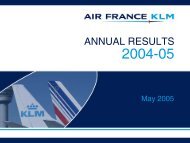Registration document 2010-11 - Air France-KLM Finance
Registration document 2010-11 - Air France-KLM Finance
Registration document 2010-11 - Air France-KLM Finance
Create successful ePaper yourself
Turn your PDF publications into a flip-book with our unique Google optimized e-Paper software.
Activity2Market and environment❚ Trend in customer behavior: increased sensitivityto the price elementIn a world that is increasingly open and “connected’’, customers arelooking for effi ciency, autonomy of decision-making and transparentinformation when it comes to making their travel choices. They arebecoming more and more sensitive to the value of the service offeredand the service/price criterion is assuming an increasingly importantrole in their purchasing. This change is particularly visible in mediumhaul, especially at the level of passengers travelling for businessreasons. Indeed, on the intra-European or intra-American markets,premium traffi c has not returned to its pre-crisis level. This trendappears to be structural for the mature markets whereas, for intra-Asia, growth in this traffi c segment was 21% in <strong>2010</strong>.In long-haul, however, premium traffi c did return to its pre-crisis levelin November <strong>2010</strong>. For example, the premium segment increasedon the Europe-Asia and Europe-South America axes by a respective12% and 8.3% relative to the 2009 levels and the number of premiumpassengers on the Europe-North Atlantic axis increased by 5% in<strong>2010</strong>. (Source: IATA Premium Monitor December <strong>2010</strong>, January andFebruary 20<strong>11</strong>).❚ Evolving operational models in medium haulThe airlines are facing an uncertain environment with challenges thatmake it diffi cult to manage growth and margin. In this context, we arewitnessing the emergence of new models, breaking the traditionalboundaries of the past: in Europe, the low cost carriers are graduallyintegrating additional service elements and the legacy carriers areendeavoring to constantly improve both the competitiveness of theirproduction costs and develop new revenues through paid-for options.easyJet has thus begun to roll out a strategy targeting customerstravelling for business and the ending of local subsidies has promptedRyanair to close a number of routes. Within this context of emergingtransmodels, Iberia has developed a close cooperation with the lowcost airline Vueling to help feed the Madrid hub. In its turnaround plan,Japan <strong>Air</strong>lines has decided to launch a low cost carrier with a dualbrandstrategy.❚ The consolidation continuesIn <strong>2010</strong>, consolidation was a key factor in the improvement inthe profi tability of the air transport industry, which remains highlycompetitive. The airline landscape has principally been redrawnthrough closer cooperation whether via mergers, which remain limiteddue to the regulatory constraints for air transport, or the developmentof alliances and joint-ventures.In <strong>2010</strong>, mergers took place in Latin America between Avianca andTACA, in Asia between China Eastern and Shanghai <strong>Air</strong>lines, and inthe United States between United <strong>Air</strong>lines and Continental <strong>Air</strong>lines. InJanuary 20<strong>11</strong>, British <strong>Air</strong>ways and Iberia created a new Group, IAG.Other mergers are expected in 20<strong>11</strong> and 2012 between LAN and TAMin Latin America and Southwest and <strong>Air</strong>Tran in the United States.Consolidation is also taking the form of new partnerships within thethree major alliances. Seven new members based in Asia, Latin Americaand the Middle East either have joined or will join the SkyTeam alliancebetween <strong>2010</strong> and 2012 (See also Activity section on page 43). TAMand Aegean <strong>Air</strong>lines joined the Star Alliance in <strong>2010</strong>. They are likely tobe followed by <strong>Air</strong> India, Ethiopian, a merged Avianca-TACA as wellas by Copa <strong>Air</strong>lines in 20<strong>11</strong>. In <strong>2010</strong> S7 <strong>Air</strong>lines became a member ofthe Oneworld alliance, and Kingfi sher <strong>Air</strong>lines and <strong>Air</strong> Berlin should jointhem respectively in 20<strong>11</strong> and 2012.Joint-ventures have also been developed on the trans-Atlantic andtrans-Pacifi c routes thanks to the Open Sky agreements. The trans-Atlantic axis is thus structured by three joint-ventures organized aroundthree European majors, <strong>Air</strong> <strong>France</strong>-<strong>KLM</strong>, Lufthansa and IAG, based onthe following groups: <strong>Air</strong> <strong>France</strong>-<strong>KLM</strong> with Delta <strong>Air</strong>lines and Alitalia,Lufthansa with United <strong>Air</strong>lines (merged with Continental <strong>Air</strong>lines)and <strong>Air</strong> Canada and, since <strong>2010</strong>, IAG and American <strong>Air</strong>lines haveestablished a commercial cooperation. In 20<strong>11</strong>, All Nippon <strong>Air</strong>waysand United <strong>Air</strong>lines are also planning to implement a trans-Pacifi cjoint-venture once they obtain approval from the US Departmentof Transportation.❚ Conclusion<strong>Air</strong> transport has successfully weathered the economic and fi nancialcrisis. Recent events have, however, increased the uncertainties thatoverhang the operational environment across the industry. The fragilerecovery is threatened by new developments which are going to testthe fundamentals. In addition to global economic uncertainty, thechange in operational models, and the consolidation and redistributionof the competitive forces outlined above, the industry is also facing thefollowing challenges:✦ the restructuring of the airlines’ balance sheets whose level of debtsignifi cantly increased during the crisis;✦ the increasing pressure due to the introduction of new taxes andregulatory measures with, for example, the entry of the industryinto the EU-ETS emissions trading system by 2012, which remainssurrounded by numerous uncertainties as to the application scopeand the risk of distorting competition to the detriment of theEuropean airlines;✦ the trend in the oil price and its volatility and the exchange rates ofthe principal currencies.The growth fundamentals are clearly present, but success will behighly dependent on the industry’s ability to adapt when confrontedwith an unstable and changing economic environment.<strong>Registration</strong> Document <strong>2010</strong>-<strong>11</strong> ■ <strong>Air</strong> <strong>France</strong>-<strong>KLM</strong>35


